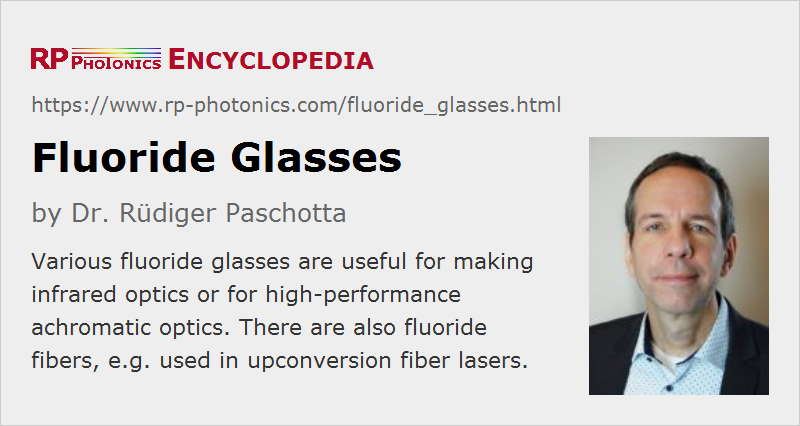Fluoride Glasses
Definition: glasses made from compounds of fluorine e.g. with zirconium, aluminum or indium
More general term: optical glasses
German: Fluoridgläser
Author: Dr. Rüdiger Paschotta
Cite the article using its DOI: https://doi.org/10.61835/gop
Get citation code: Endnote (RIS) BibTex plain textHTML
Fluoride glasses belong to the non-oxide glasses, made from compounds of fluorine with zirconium, for example (fluorozirconate glass), or with aluminum (fluoroaluminate glasses). They can also contain various other heavy metals like lead. There are also indium fluoride glasses (fluoroindate glasses) with improved infrared transmission at longer wavelengths.
Fluoride glasses are notoriously difficult to produce with high optical quality. They have a high tendency for partial crystallization during the glass transition, and the resulting microcrystallites can deteriorate the transparency. Further, they are difficult to use, since they are mechanically quite weak (fragile) and chemically not resistant to moisture, for example.
Mixtures of phosphate and fluoride glasses are called fluorophosphate glasses.
Fluoride and fluorophosphate glasses can be used as high-index low-dispersion glasses, e.g. for the construction of achromatic optics with particularly high performance. Due to the high cost of fluoride optics, however, its use for such purposes is limited.
A special property of heavy-metal fluoride glasses is their good transmission in the infrared spectral region. (This results from the low photon energies, which reduce the rates of multi-phonon transitions.) Therefore, mid-infrared fluoride fibers were once thought to be a good candidate for long-distance optical fiber communications: the intrinsic scattering losses could in principle be lower than those of silica fibers because of the longer operation wavelengths which would be possible with fluoride fibers. However, silica fibers have firmly occupied this application area for various reasons like fabrication cost, mechanical strength, available light sources and fiber amplifiers.
Among the fluorozirconate glasses for fibers, ZBLAN (ZrF4-BaF2-LaF3-AlF3-NaF) is the most common. Such fibers can be doped with a number of rare earth ions for application in fiber lasers and amplifiers. Due to the high phonon energies, the lifetimes of various metastable electronic levels can be strongly increased compared with silica fibers, allowing the realization of certain lasers and amplifiers operating in the mid infrared. Also, there are fluoride-based upconversion lasers in the form bulk lasers or fiber lasers. Such fluoride glasses can be doped with thulium (Tm3+) or praseodymium (Pr3+), for example.
More to Learn
Encyclopedia articles:
Questions and Comments from Users
Here you can submit questions and comments. As far as they get accepted by the author, they will appear above this paragraph together with the author’s answer. The author will decide on acceptance based on certain criteria. Essentially, the issue must be of sufficiently broad interest.
Please do not enter personal data here; we would otherwise delete it soon. (See also our privacy declaration.) If you wish to receive personal feedback or consultancy from the author, please contact him, e.g. via e-mail.
By submitting the information, you give your consent to the potential publication of your inputs on our website according to our rules. (If you later retract your consent, we will delete those inputs.) As your inputs are first reviewed by the author, they may be published with some delay.

 optical materials
optical materials
Share this with your friends and colleagues, e.g. via social media:
These sharing buttons are implemented in a privacy-friendly way!